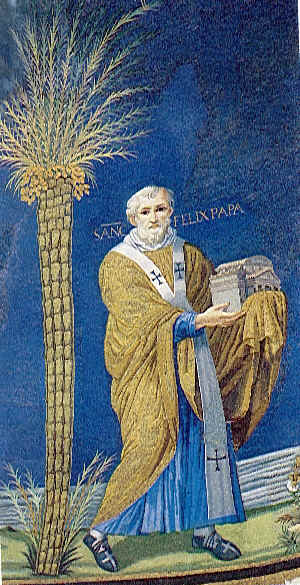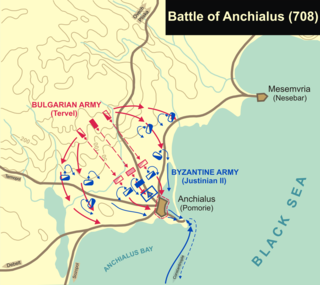
The terms anno Domini (AD) and before Christ (BC) are used when designating years in the Gregorian and Julian calendars. The term anno Domini is Medieval Latin and means "in the year of the Lord" but is often presented using "our Lord" instead of "the Lord", taken from the full original phrase "anno Domini nostri Jesu Christi", which translates to "in the year of our Lord Jesus Christ". The form "BC" is specific to English, and equivalent abbreviations are used in other languages: the Latin form, rarely used in English, is ante Christum natum (ACN) or ante Christum (AC).

Ab urbe condita, or anno urbis conditae, abbreviated as AUC or AVC, expresses a date in years since 753 BC, the traditional founding of Rome. It is an expression used in antiquity and by classical historians to refer to a given year in Ancient Rome. In reference to the traditional year of the foundation of Rome, the year 1 BC would be written AUC 753, whereas AD 1 would be AUC 754. The foundation of the Roman Empire in 27 BC would be AUC 727. The current year AD 2025 would be AUC 2778.

The 6th century is the period from 501 through 600 in line with the Julian calendar.
Year 800 (DCCC) was a leap year starting on Wednesday of the Julian calendar, the 800th year of the Common Era (CE) and Anno Domini (AD) designations, the 800th year of the 1st millennium, the 100th and last year of the 8th century, and the 1st year of the 800s decade. It was around this time that the Anno Domini calendar era became the prevalent method in Europe for naming years, so from this time on, the years began to be known as 800 and onwards.
AD 1 (I) or 1 CE was a common year starting on Saturday or Sunday, a common year starting on Saturday by the proleptic Julian calendar, and a common year starting on Monday by the proleptic Gregorian calendar. It is the epoch year for the Anno Domini (AD) Christian calendar era, and the 1st year of the 1st century and 1st millennium of the Christian or Common Era (CE).
The 520s decade ran from January 1, 520, to December 31, 529.

Year 450 was a common year starting on Sunday of the Julian calendar, the 450th Year of the Common Era (CE) and Anno Domini (AD designations, the 450th year of the 1st millennium, the 50th year of the half of 5th century, and the 1st year of the 450s decade. At the time, it was known as the Year of the Consulship of Valentinianus and Avienus. The denomination 450 for this year has been used since the early medieval period, when the Anno Domini calendar era became the prevalent method in Europe for naming years.

Year 526 (DXXVI) was a common year starting on Thursday of the Julian calendar. At the time, it was known as the Year of the Consulship of Olybrius without colleague. The denomination 526 for this year has been used since the early medieval period, when the Anno Domini calendar era became the prevalent method in Europe for naming years.

Year 532 (DXXXII) was a leap year starting on Thursday of the Julian calendar. At the time, it was known as the Second year after the Consulship of Lampadius and Probus. The denomination 532 for this year has been used since the early medieval period, when the Anno Domini calendar era became the prevalent method in Europe for naming years.

Year 540 (DXL) was a leap year starting on Sunday of the Julian calendar. In the Roman Empire, it was known as the Year of the Consulship of Iustinus without colleague. The denomination 540 for this year has been used since the early medieval period, when the Anno Domini calendar era became the prevalent method in Europe for naming years.

Year 470 (CDLXX) was a common year starting on Thursday of the Julian calendar. At the time, it was known as the Year of the Consulship of Severus and Iordanes. The denomination 470 for this year has been used since the early medieval period, when the Anno Domini calendar era became the prevalent method in Europe for naming years.

Year 520 (DXX) was a leap year starting on Wednesday of the Julian calendar. In the Roman Empire, it was known as the Year of the Consulship of Rusticus and Vitalianus. The denomination 520 for this year has been used since the early medieval period, when the Anno Domini calendar era became the prevalent method in Europe for naming years.

Year 530 (DXXX) was a common year starting on Tuesday of the Julian calendar. In the Roman Empire, it was known as the Year of the Consulship of Lampadius and Probus. The denomination 530 for this year has been used since the early medieval period, when the Anno Domini calendar era became the prevalent method in Europe for naming years.

Year 544 (DXLIV) was a leap year starting on Friday of the Julian calendar. The denomination 544 for this year has been used since the early medieval period, when the Anno Domini calendar era became the prevalent method in Europe for naming years.

Year 708 (DCCVIII) was a leap year starting on Sunday of the Julian calendar, the 708th year of the Common Era (CE) and Anno Domini (AD) designations, the 708th year of the 1st millennium, the 8th year of the 8th century, and the 9th year of the 700s decade. The denomination 708 for this year has been used since the early medieval period, when the Anno Domini calendar era became the prevalent method in Europe for naming years.
Year 580 (DLXXX) was a leap year starting on Monday of the Julian calendar. The denomination 580 for this year has been used since the early medieval period, when the Anno Domini calendar era became the prevalent method in Europe for naming years.

Year 1 BC was a common year starting on Friday or Saturday in the Julian calendar and a leap year starting on Thursday in the proleptic Julian calendar. It was also a leap year starting on Saturday in the Proleptic Gregorian calendar. At the time, it was known as the Year of the Consulship of Lentulus and Piso. The denomination 1 BC for this year has been used since the early medieval period when the Anno Domini calendar era became the prevalent method in Europe for naming years. The following year is AD 1 in the widely used Julian calendar and the proleptic Gregorian calendar, which both do not have a "year zero".

Dionysius Exiguus was a 6th-century Eastern Roman monk born in Scythia Minor. He was a member of a community of Scythian monks concentrated in Tomis, the major city of Scythia Minor. Dionysius is best known as the inventor of Anno Domini (AD) dating, which is used to number the years of both the Gregorian calendar and the (Christianised) Julian calendar. Almost all churches adopted his computus for the dates of Easter.
The Era of the Martyrs, also known as the Diocletian era, is a method of numbering years based on the reign of Roman Emperor Diocletian who instigated the last major persecution against Christians in the Empire. It was used by the Church of Alexandria beginning in the 4th century AD and it has been used by the Coptic Orthodox Church of Alexandria from the 5th century until the present. This era was used to number the year in Easter tables produced by the Church of Alexandria.
A year zero does not exist in the Anno Domini (AD) calendar year system commonly used to number years in the Gregorian calendar ; in this system, the year 1 BC is followed directly by year AD 1. However, there is a year zero in both the astronomical year numbering system, and the ISO 8601:2004 system, a data interchange standard for certain time and calendar information. There is also a year zero in most Buddhist and Hindu calendars.













